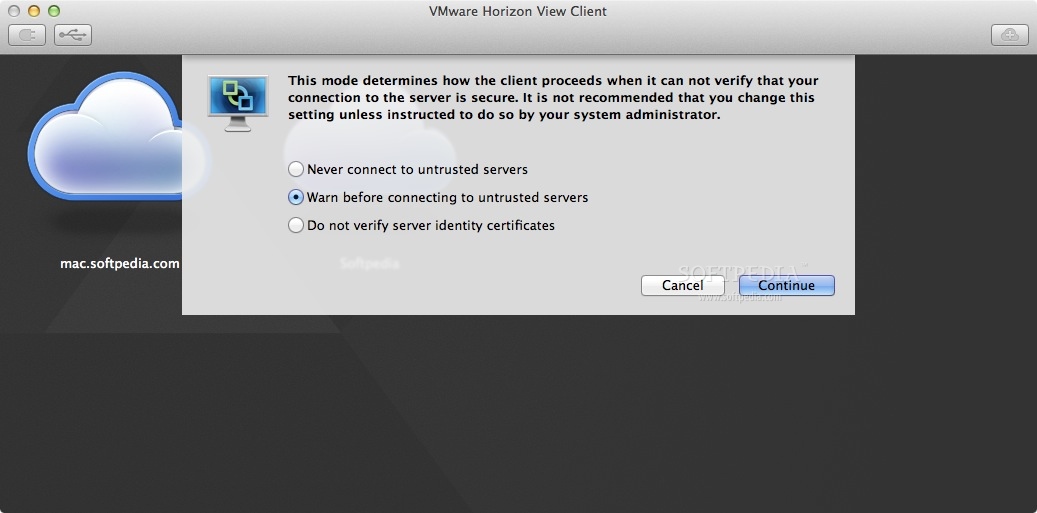

- VMWARE HORIZON CLIENT FOR MAC M1 ANDROID
- VMWARE HORIZON CLIENT FOR MAC M1 PC
- VMWARE HORIZON CLIENT FOR MAC M1 FREE
It does when running Windows or Android on the Raspberry Pi.
VMWARE HORIZON CLIENT FOR MAC M1 PC
It will not do PC over IP on a Raspberry Pi running Linux. Short story short: Yes the Horizon Client works on a Raspberry Pi! But not how you may think. I decided that I could use one of them to test if using a Raspberry Pi 4B (4GB) for work was feasible. I do have a bunch of Raspberry Pi 4’s stacked, which I use for either Kubernetes or ESXi on ARM. I needed to find a reasonable alternative, I don’t want to have yet another PC on my desk only for some remote desktop stuff. It just locks up (I’ve got alot of stuff, including VM’s running on the background, so probably my own fault). Don’t know why, haven’t found anything, PC just freezes, leaving no trace of any issue in any log/eventlog. If the value you enter is invalid, the default value remains. The default value is VmwH264Speex however, you can change to VmwTheoraSpeex. Sure I do, but my primary PC has some issue when running the Horizon View and the Microsoft Teams clients, it gets unstable. Horizon Client for Mac 2111 includes the following new features: Codec Parameter is Configurable for Real-Time Audio-Visual (RTAV) You can set the compression technology used by RTAV. But why? Don’t you have a PC or laptop for that? The customer for whom I work at the moment uses a VMware Horizon VDI infrastructure, so working from home is basically the same as working from the office, bar the co-workers. What works, what doesn’t.ĭue to the COVID restrictions, and the push for working from home, I’ve been at home for the last 18 months. In this blog I’m discussing multiple options to use an Raspberry Pi 4 as a VMware Horizon View 8 Thin Client. Posted in Uncategorized | Tagged charts, graphs, powercli, vmware | Leave a comment The Quest for VMware Horizon View Client with PC over IP on Raspberry Pi

GenerateChart -ChartType FastLine -VirtualMachine $_ -Statistic "","","" -Days 7 -FilePath C:\MyReports #$VMs = Import-CSV C:\MyReports\VirtaulMachines.csv -Delimiter ',' | Select-Object $_.VirtualMachineName #$VMs = Get-Content C:\MyReports\InputList.txt It needs a CSV inputfile with some information, which can all be exported from vCenter: = Import-CSV C:\MyFiles\BloatedVMs.csv -Delimiter " " Reclaiming 51 GB from a Thin Provisioned VM In my experience it takes 15-30 min for a 80GB volume. Don’t worry when the output halts at “SDelete is set for 1 pass.” it will take some time. And it assumes that the machine has a D:\ disk where it can put the sDelete.exe file. The script now only deals with the C:\ disk (since that was the disk on my machines, but can be easily be adapted to work multiple disks. All without powering down the machine or the need for vmkfstools.
VMWARE HORIZON CLIENT FOR MAC M1 FREE
It will vMotion the VM to the datastore with the largest free space available, push sDelete.exe to the machine, runs sDelete, vMotions the machine back to it’s original datastore. But I needed to do it for many VMs, so I wrote a script. There is a Knowledge Base article about this, and it explains exactly what to do. This is something that happens, if the disk has been written to, the VMDK inflates, when the files are deleted the VMDK may not shrink. The Guest OS reported 60 GB of an 80 GB volume being free, but the VMDK was 80GB is size.

vMotion (explicitly choosing target type Thin didn’t help either. I came across some VMs that although being Thin Provisioned took up all the diskspace that they could.


 0 kommentar(er)
0 kommentar(er)
